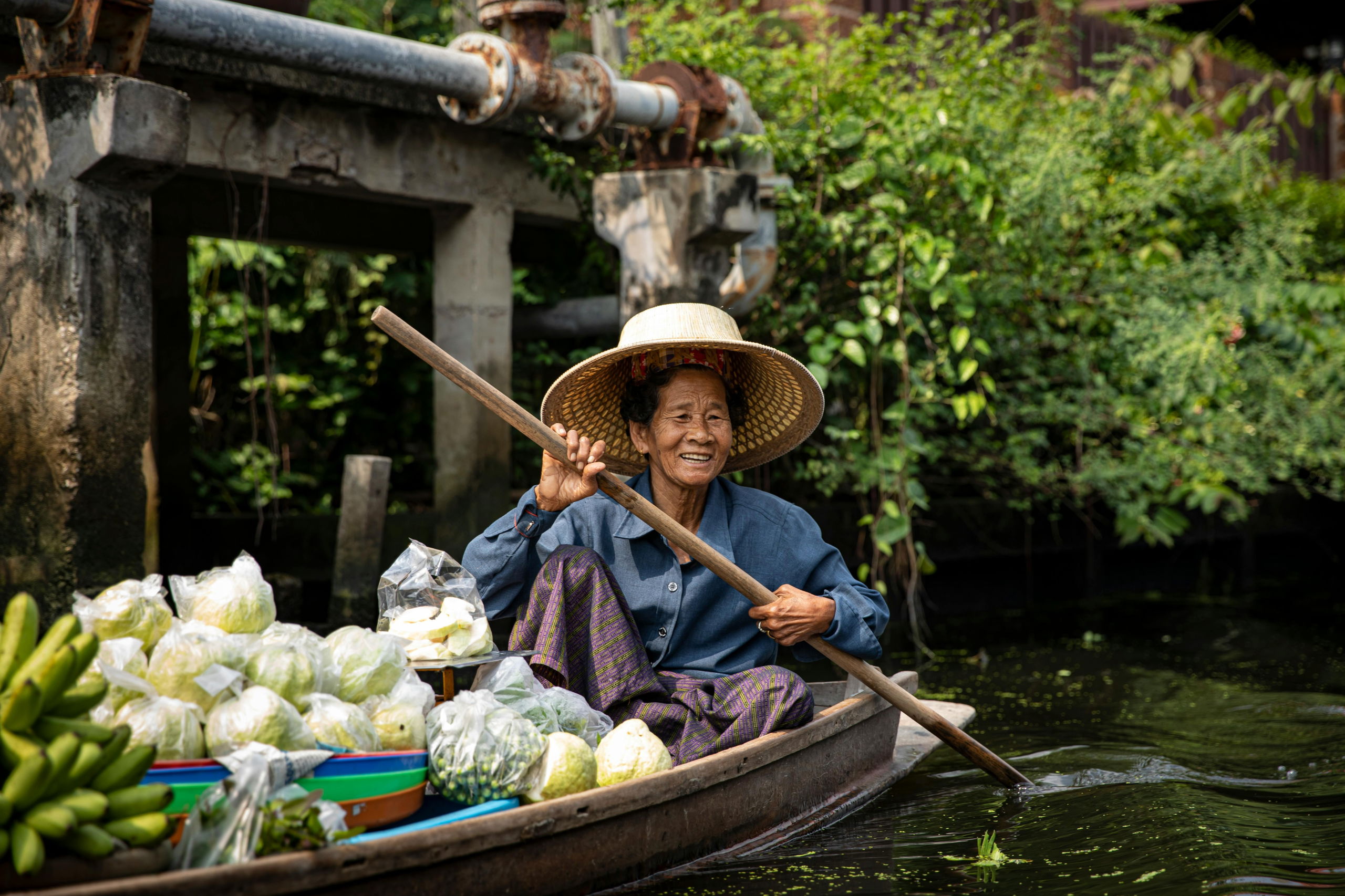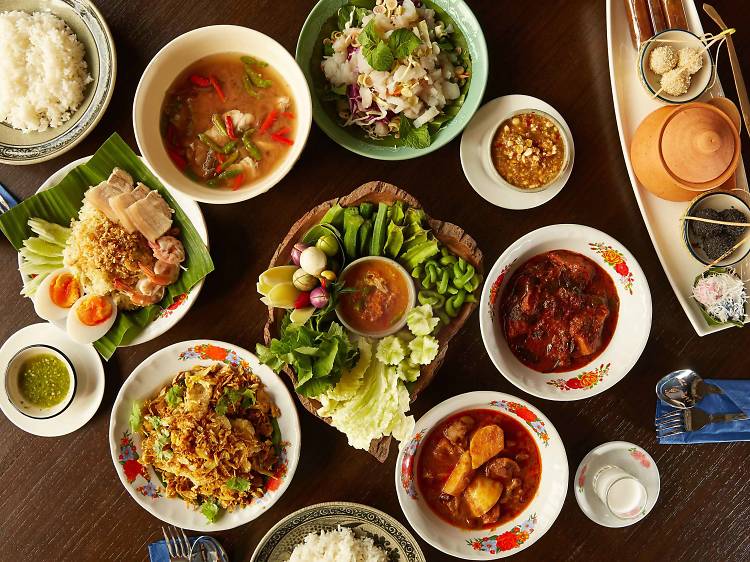
In a Bangkok shophouse kitchen, a grandmother grinds chilies and galangal in a granite mortar, the pestle striking a rhythm her hands learned sixty years ago. She doesn’t measure. The red curry paste she’s building exists in her muscle memory, passed down from her own grandmother when all Thai cooking happened over charcoal. Traditional Thai food isn’t a collection of recipes you can download and replicate. It’s a language spoken through ingredients, techniques, and an understanding of balance so intuitive that Thai cooks often can’t explain what they’re doing. They just know when it tastes right.
A Taste Tour of Thailand’s Regions
Thailand stretches from misty northern mountains to tropical southern beaches, and the food changes with the landscape. Geography dictates what grows, what swims in nearby waters, what trading ships brought centuries ago. Thai cuisine is actually dozens of regional cuisines that share fundamental principles but express them in wildly different ways.
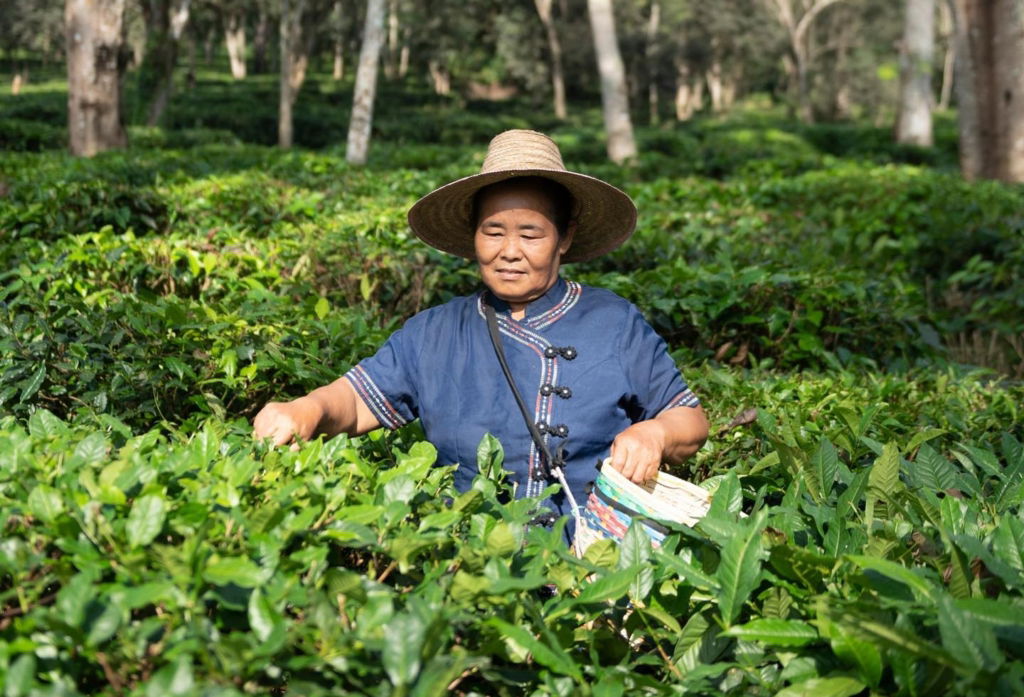
Northern Thai Comfort and Complexity
In Chiang Mai, the air smells of wood smoke and turmeric. The food here reflects the cooler climate and the ancient Lanna Kingdom’s influence. Khao soi—curry noodles swimming in a coconut-laced broth, crowned with crispy fried noodles and pickled mustard greens—appears at nearly every northern table. The curry paste contains dried chilies roasted until they’re almost black, ground with shallots, garlic, and ginger.
Sai oua, the region’s famed pork sausage, is stuffed with lemongrass, kaffir lime leaves, galangal, and chilies, then grilled until the casing crisps and splits. Locals eat it with sticky rice and fresh vegetables such as cabbage, cucumbers, Thai basil that cut through the richness. Vendors at Warorot Market sell bundles of ingredients you won’t find in Bangkok: yanang leaves for soup, cha-om (acacia) for omelets, lengths of wild ginger thick as your wrist.
Northern preservation techniques created the deep, funky flavors that still define the region. Naem, a fermented pork sausage wrapped in banana leaves, tastes sour and garlicky, its pink color coming from rice that turns it slightly alcoholic as it cures.
Southern Thai Spice and Sea
Four hours south, the food becomes something else entirely. Where coconut palms outnumber people, Thai cuisine takes on Malaysian and Indonesian inflections. Turmeric stains everything yellow. Curries achieve levels of heat that make even Bangkok natives sweat.
Southern cooks use coconut cream so thick it splits when you heat it, releasing oil that becomes the base for gaeng tai pla, a curry so pungent with fermented fish innards that hotels sometimes ban guests from cooking it. Fresh turmeric root gets pounded into nearly every curry paste, creating dishes that glow golden, their heat tempered by coconut sweetness and tamarind’s sour punch.
At dawn, fishing boats unload baskets of mackerel, squid, prawns still flipping, and fish so fresh their scales gleam like metal. Southern Thais grill fish whole over coconut husks. They make khua kling, a dry curry of minced pork or fish cooked until nearly all liquid evaporates, leaving only concentrated spice clinging to the meat.
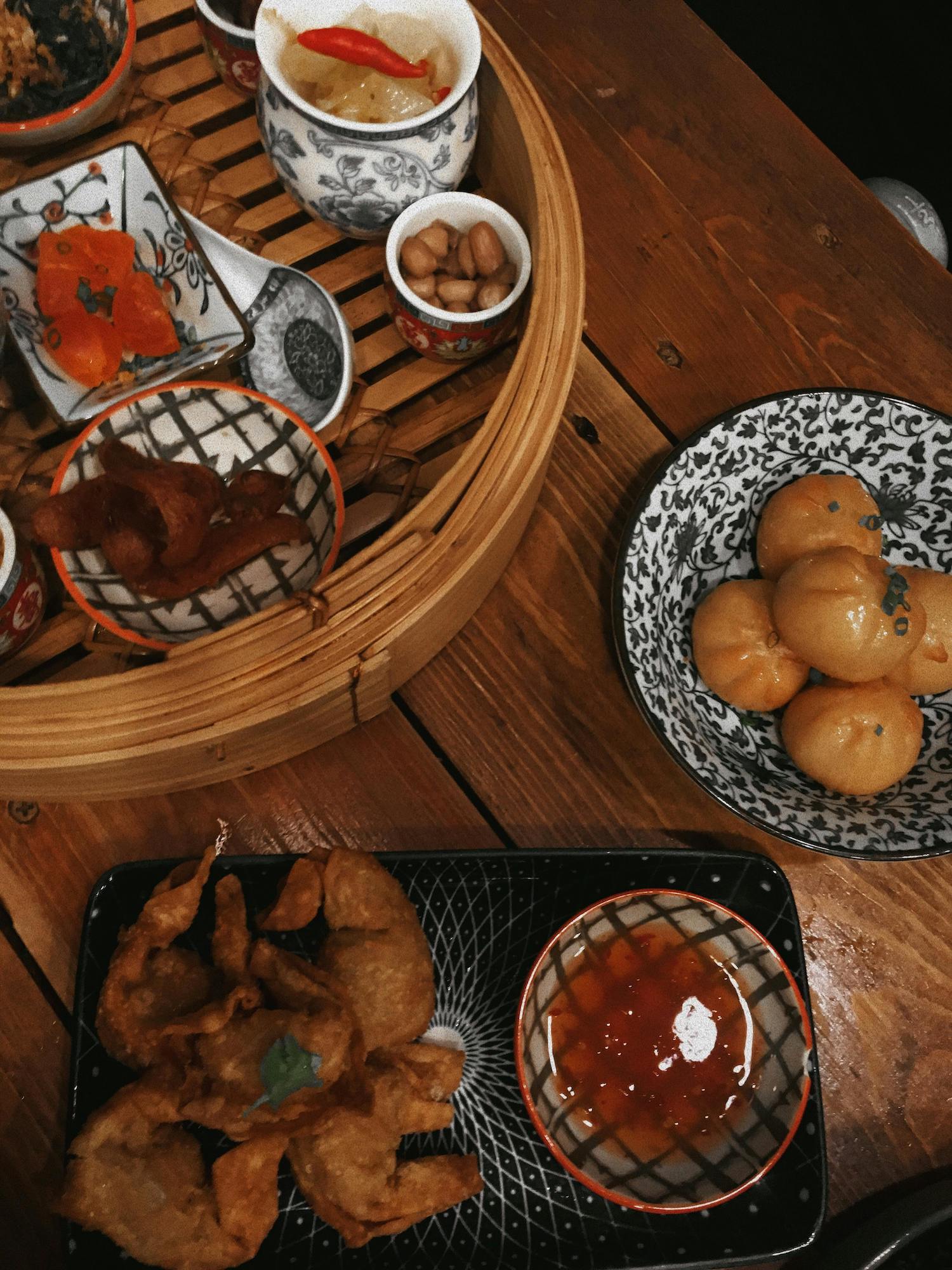
Thai Street Food: Flavor and Unspoken Rules
Bangkok after dark transforms into an open-air restaurant. Vendors set up on every sidewalk, their carts lit by single bulbs. The smell of grilled pork skewers competes with the sweet-sour funk of som tam being pounded in wooden mortars. Office workers in heels pick their way between plastic stools, ordering in rapid Thai from women who’ve been working these same corners for decades.
Street food in Thailand operates on unspoken rules that locals absorb from childhood. You don’t wave money or shout orders. You wait, watch what others are eating, then point or speak softly when it’s your turn. The etiquette extends to eating: you take what you need from the communal condiment tray—dried chilies, fish sauce with sliced chilies, sugar, vinegar—and adjust the flavor yourself.
How to Order Like a Local in Bangkok
The first phrase you need is “mai phet” (not spicy), though uttering it marks you as foreign. Thais specify their spice level: “phet nit noi” (a little spicy), “phet maak” (very spicy), or “phet mak mak” (spicy spicy). At noodle carts, locals request “sen yai” (wide noodles) or “sen lek” (thin noodles), then specify “nam” (soup) or “haeng” (dry).
The real skill is knowing when to arrive. Khao tom vendors serving rice porridge work through the night. Jok (congee) stands open before dawn, catching construction workers and taxi drivers. The best pad krapow—holy basil with pork or chicken over rice, topped with a fried egg—comes at lunch when the wok stays hot and the basil hasn’t wilted.

Markets as Living Culinary Classrooms
Thai markets teach you to cook by teaching you to shop. Every morning, home cooks and restaurant chefs make the same pilgrimage to their neighborhood talat, where vendors have been selling from the same concrete stalls for generations. These are working markets where you buy a live chicken and the vendor butchers it while you wait, where fish are gutted to order, where the woman selling curry pastes ground them herself at 4 a.m.
The market reveals what’s in season because that’s all that’s available. During mango season, vendors pile yellow and green fruit in pyramids. Thai cooks don’t plan meals around recipes; they plan around what looks good that morning.
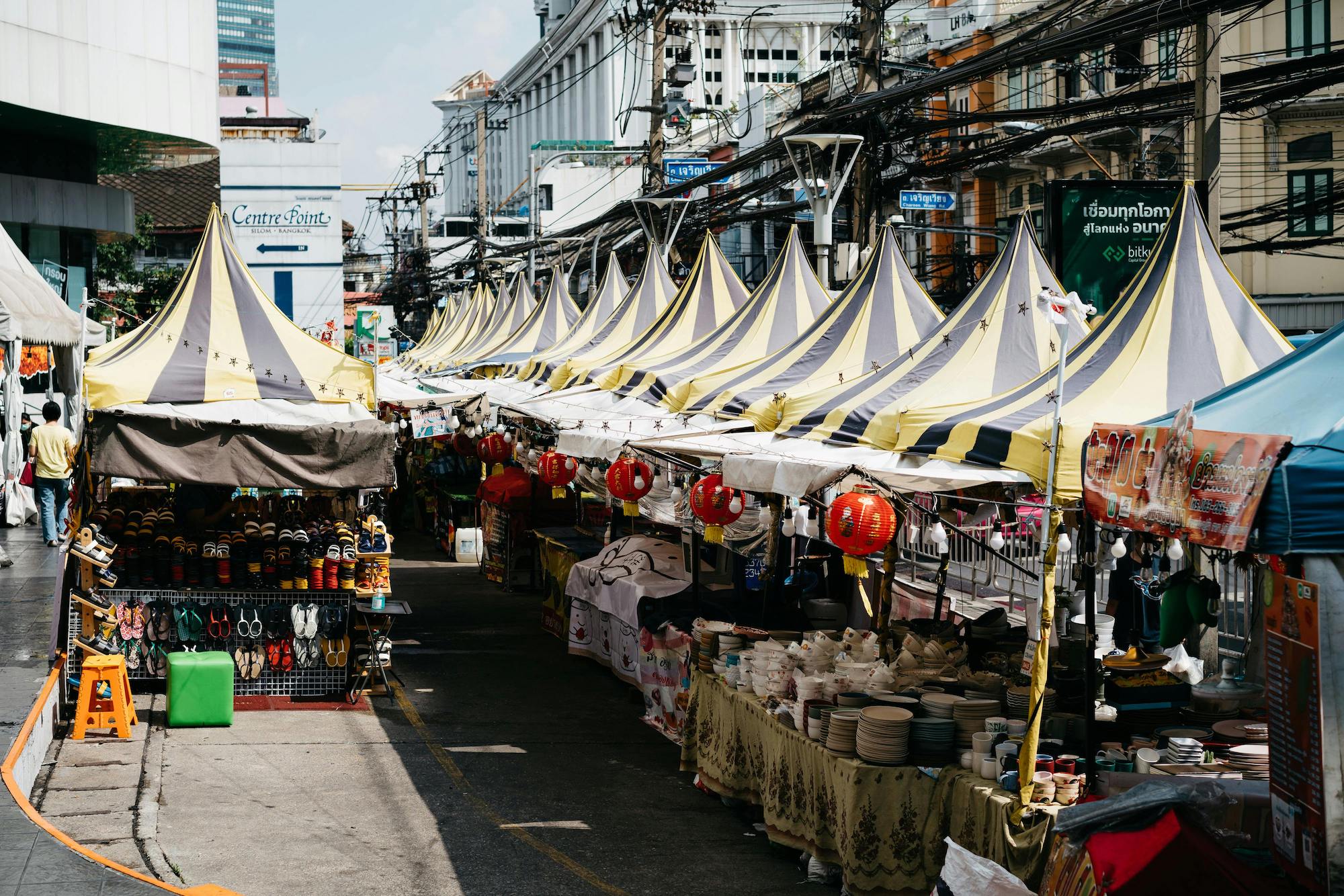
Mastering the Morning Market
Arrive by seven for the best selection. Look for Thai eggplants the size of golf balls, their skin tight and green. Smell the holy basil before you buy it; fresh leaves should smell like licorice and cloves.
For fish sauce, trust the cloudiness. The clearest bottles lack the depth of traditionally fermented sauce, which looks slightly murky and smells powerfully of umami. Palm sugar should come in dense discs, not granules. Real palm sugar tastes complex, like caramel with a mineral finish.
Kaffir lime leaves have an hourglass shape that look like two leaves fused together. Fresh galangal is harder and more fibrous than ginger, with pink shoots when it’s young.
Thai Rice: More Than a Side Dish
Rice isn’t just food in Thailand. It’s the anchor of every meal, the word Thais use when they say “eat” (kin khao, literally “eat rice”). The variety matters more than most foreigners realize.
- Jasmine rice (khao hom mali): Long grains that smell faintly of pandan when cooked, with a texture that’s tender but distinct. This is the rice for curries, stir-fries, and most central and southern Thai dishes.
- Sticky rice (khao niao): Short, opaque grains that steam in woven bamboo baskets, emerging glossy and cohesive enough to eat with your hands. Northern and northeastern Thais eat this at every meal, rolling it into balls to scoop up grilled meats and larb.
- Black sticky rice (khao niao dam): Nearly purple when cooked, nutty and slightly sweet. Almost exclusively reserved for desserts, cooked with coconut milk and palm sugar.
- Red cargo rice (khao deng): Unhulled rice with a red bran layer, giving it a chewy texture and earthy flavor.
- Riceberry: A relatively new variety developed in Thailand, deep purple with high antioxidants. You’ll see it in modern Thai restaurants bridging tradition and wellness trends.
The Rituals of Thai Rice Cooking
Thai cooks rinse rice until the water runs clear, removing excess starch to prevent gumminess. The old method involves soaking jasmine rice for thirty minutes before cooking, then steaming it in a pot with a tight-fitting lid, undisturbed while it cooks, then rested for ten minutes after the heat cuts off.
Sticky rice requires different treatment. Northern cooks soak it overnight, then steam it in conical bamboo baskets set over boiling water. The rice never touches the water directly. After twenty minutes, they flip the entire mass and steam another ten minutes, producing rice that’s translucent and sticky enough to hold together but not gluey.
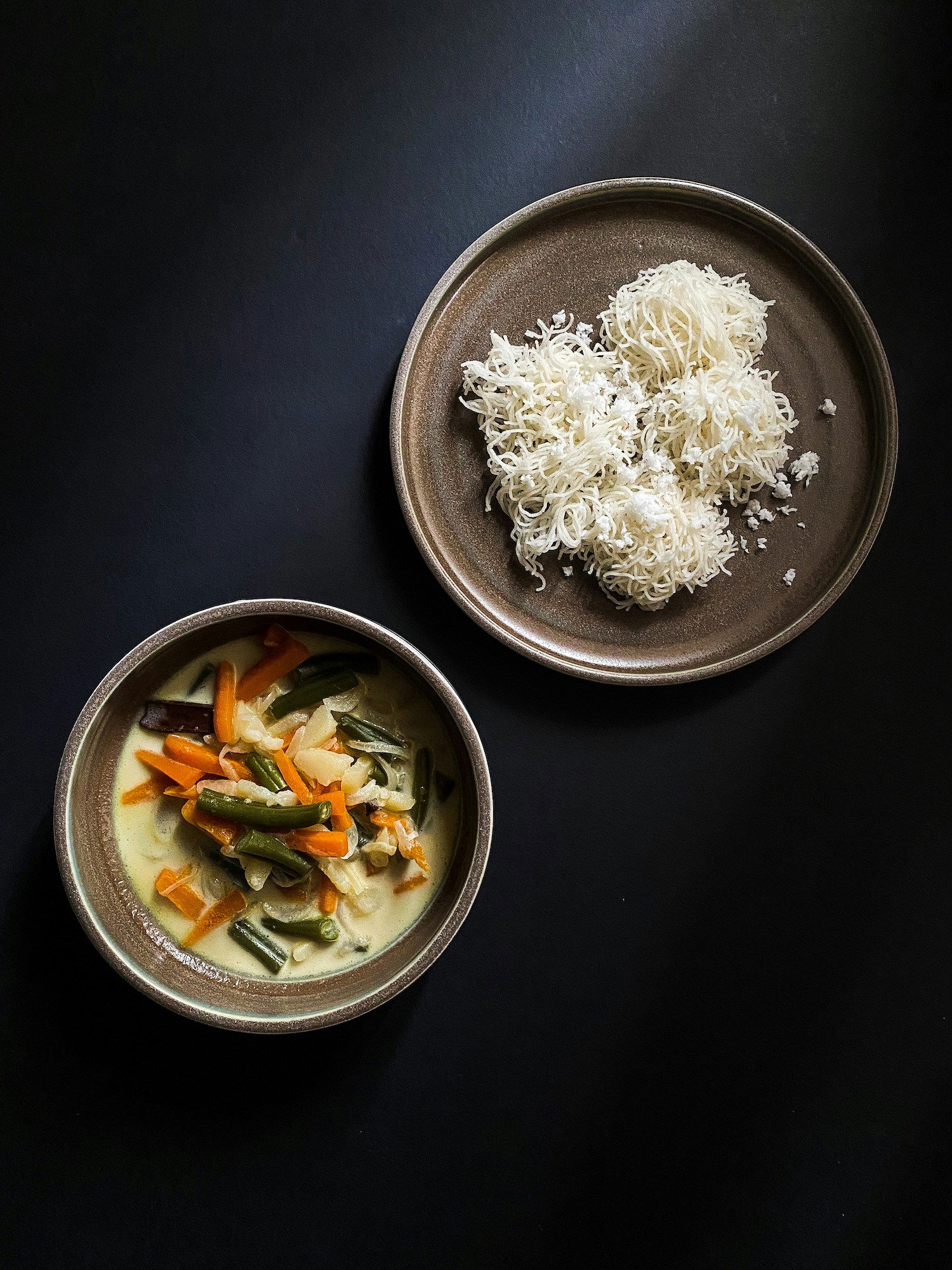
Building Flavor: The Power of Curry Paste
Before you can make Thai curry, you need paste. Not the jarred stuff—that’s a convenience food, nothing like what builds real flavor. Thai curry paste (nam prik gaeng) is the foundation where Thai cooking diverges completely from other Southeast Asian cuisines.
Making curry paste requires a heavy stone mortar and pestle. You start with dried chilies toasted until they darken, then soaked until pliable. These get pounded first, ground against the stone until they break down. Then garlic, then shallots, then cilantro root, then galangal, then lemongrass. Each ingredient gets fully incorporated before you add the next. The whole process takes forty minutes of steady pounding.
When you fry the paste in coconut cream, it should bloom—the oils separate and the paste darkens and becomes fragrant. That’s when it’s ready for liquid and protein.
Ingredients That Make It Thai
Red curry paste gets its heat from dried red chilies. Green curry paste uses fresh green chilies, making it technically hotter despite looking milder. Massaman curry paste includes spices that arrived via Muslim traders like cinnamon, cardamom, and star anise.
The herbs distinguish Thai pastes from everything else. Galangal appears in nearly every paste. Lemongrass adds citrus without acid. Kaffir lime rind contributes bitter aromatics. Cilantro root provides earthiness. Shrimp paste gives the umami depth that makes Thai curries taste complete even before you add fish sauce.
For home cooks outside Thailand, the mortar and pestle matter more than you’d think. Food processors chop rather than grind, leaving the paste grainy and the flavors poorly integrated.
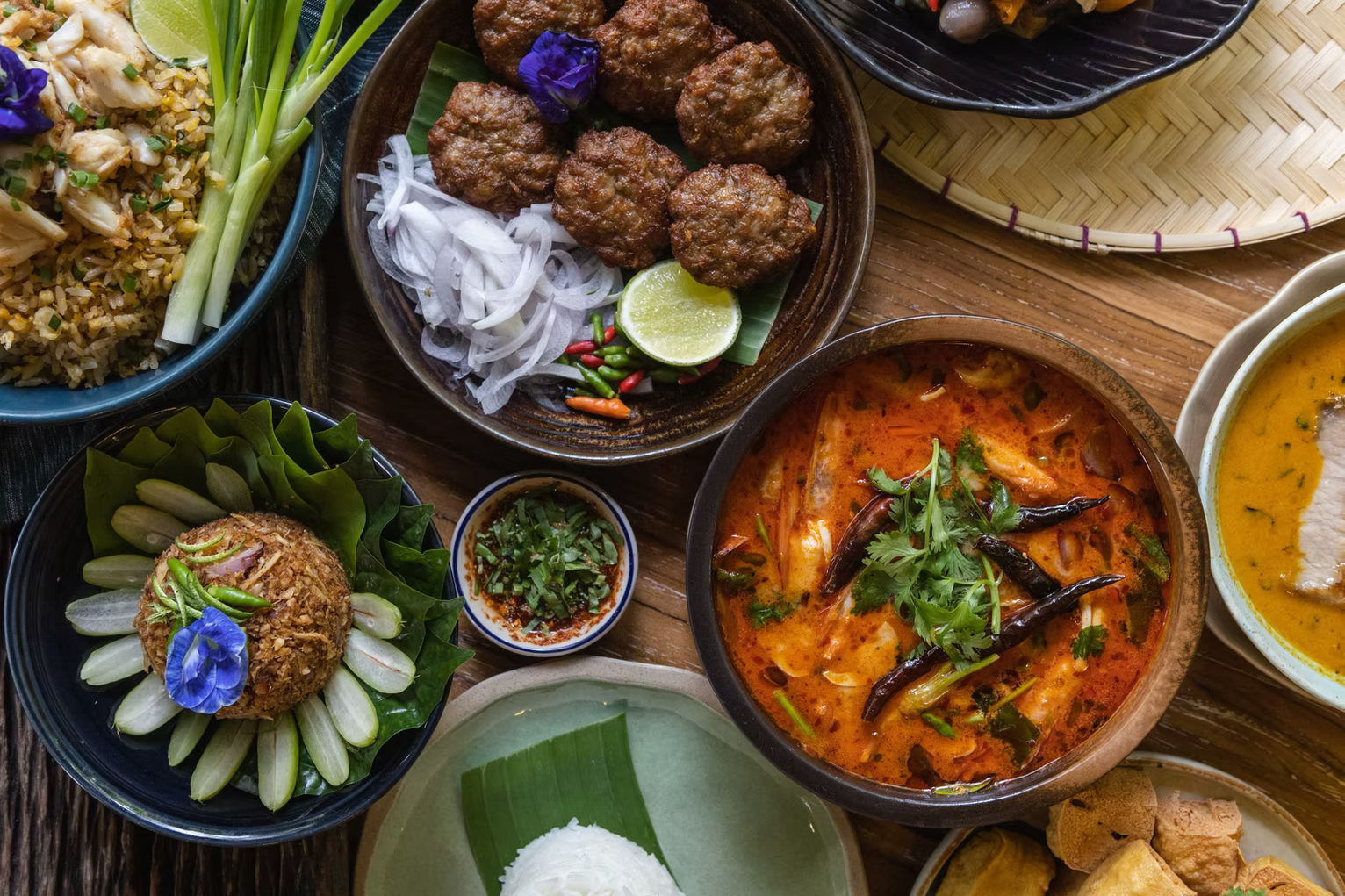
Mastering Thai Flavor Balance
Thai cooks talk about balance the way Western chefs discuss technique. Every dish should hit four notes: sweet, sour, salty, and spicy. But balance doesn’t mean equal parts. A good pad thai tastes sweet from palm sugar, sour from tamarind, salty from fish sauce, and spicy from dried chilies, but you’d struggle to identify which taste dominates.
This balance extends beyond individual dishes to entire meals. Thai families serve four or five dishes simultaneously: maybe a curry, a stir-fry, a soup, a salad, and always rice. One dish might be rich and coconut-heavy, another sharp with lime and fish sauce, a third loaded with chilies. Together, they create balance across the table.
Learning to Taste Like a Thai Chef
Start by making the same dish repeatedly. Choose something simple, maybe tom yum soup or a basic stir-fry with holy basil. Make it once following a recipe exactly. Then make it again, adjusting the fish sauce by half a tablespoon. Notice what changes. Add more lime. Less sugar. An extra chili. Thai cooks taste constantly while they cook, monitoring the balance and making microscopic adjustments. This is why Thai recipes often list fish sauce “to taste” or chilies “as desired.”
The best education is eating widely. Try the same dish at ten different restaurants and notice the variations. Within those variations, good cooks always achieve balance.
Thai Food Is Meant to Be Shared
Walk into a Thai home at dinnertime and you’ll find dishes covering the table, far more food than the number of people suggests necessary. This is the fundamental structure of Thai meals, where variety matters more than quantity. Everyone gets rice on their own plate, then takes small portions from the shared dishes, mixing bites to create their preferred balance of flavors.
Table Traditions and Etiquette
The spoon and fork method surprises foreigners. Thais eat with a spoon in their right hand and fork in their left, using the fork only to push food onto the spoon. Knives don’t appear because everything’s already cut into bite-sized pieces in the kitchen.
Take from the communal dishes with serving spoons, not your personal spoon. Put a small portion on your rice, eat it, then take more. Don’t pile your plate high. The youngest person typically serves elders first and refills water glasses throughout the meal.
If someone invites you to their home, bring fruit or dessert. Take off your shoes at the door. Never point your feet at other people or at the family’s Buddha shrine.
Cooking With the Seasons in Thailand
Thailand has three seasons: hot, hotter, and wet. The monsoon dictates Thai cooking more than any calendar. When the rains come in late May, markets flood with vegetables that thrive in water-logged soil. Morning glory appears by the ton, stir-fried with garlic, chilies, and fermented soybean paste.
The dry season brings different ingredients. Mangoes ripen from March through May, eaten both green (shredded for salads) and ripe (golden and sweet, served with sticky rice and coconut cream). Rambutans come in June. Durian season peaks around July.
Monsoon Meals and Ingredient Wisdom
The rainy season calls for soups and curries. Tom yum reaches peak popularity, its sharp lime and lemongrass cutting through the heaviness of tropical rain. Gaeng jued, a mild soup with pork, tofu, and vegetables, appears at family tables throughout the monsoon months.
Farmers catch freshwater fish—catfish, snakehead, climbing perch—in the irrigation channels. These go into fish curries or get grilled whole, stuffed with lemongrass and salt.

Food and Faith: Thai Temple Cuisine
Buddhism shapes Thai cooking in ways both obvious and subtle. Most Thais eat meat, but they observe vegetarian days during Buddhist festivals. The ninth month of the lunar calendar brings the Vegetarian Festival, when devout Buddhists eat only plant-based foods for nine days.
Temple cuisine takes this further. Monastery kitchens serve hundreds of monks and laypeople daily, cooking massive pots of curry and rice. The food is simple but carefully prepared, following the principle that cooking for monks generates merit for the cook.
Cooking as a Gift: Meals for Merit
Every morning across Thailand, monks walk through neighborhoods carrying alms bowls, and families wait outside with prepared food. This isn’t charity—it’s a reciprocal exchange where laypeople gain spiritual merit by giving food.
The practice shapes daily cooking rhythms. Devout households wake early to prepare food for the monks’ rounds, usually around 6 or 7 a.m. The food should be the best they can offer.
On Buddhist holy days, families bring elaborate meals to temples. These gatherings are where younger generations watch older relatives cook, where recipes get transmitted through observation rather than written instruction.
Thai Food in the Modern World
In Bangkok’s Sukhumvit neighborhood, a restaurant serves tom yum foam on a spoon with a single grilled prawn. Three blocks away, a street vendor makes the same soup in a battered pot over a gas burner. Both versions are Thai food, separated by technique and price but connected by the fundamental flavors.
Modern Thai chefs—many trained in European kitchens—are reexamining traditional dishes through techniques borrowed from molecular gastronomy. They clarify curry broths until they’re transparent, smoke ingredients with applewood instead of charcoal, present dishes on slate rather than plates.
Fusion That Honors the Source
Chef Thitid “Ton” Tassanakajohn at Le Du in Bangkok serves Thai ingredients through French technique: grilled mackerel with green mango and coconut ash, rice crackers with aged beef. The ingredients are Thai, many sourced from small farms. The techniques are imported. But the flavors remain recognizably Thai because Ton understands balance.
The Thai chefs earning international attention—Bee Satongun at Paste, Garima Arora at Gaa—succeed because they studied traditional Thai cooking before they reimagined it. Their modern interpretations work because they’re built on genuine knowledge.
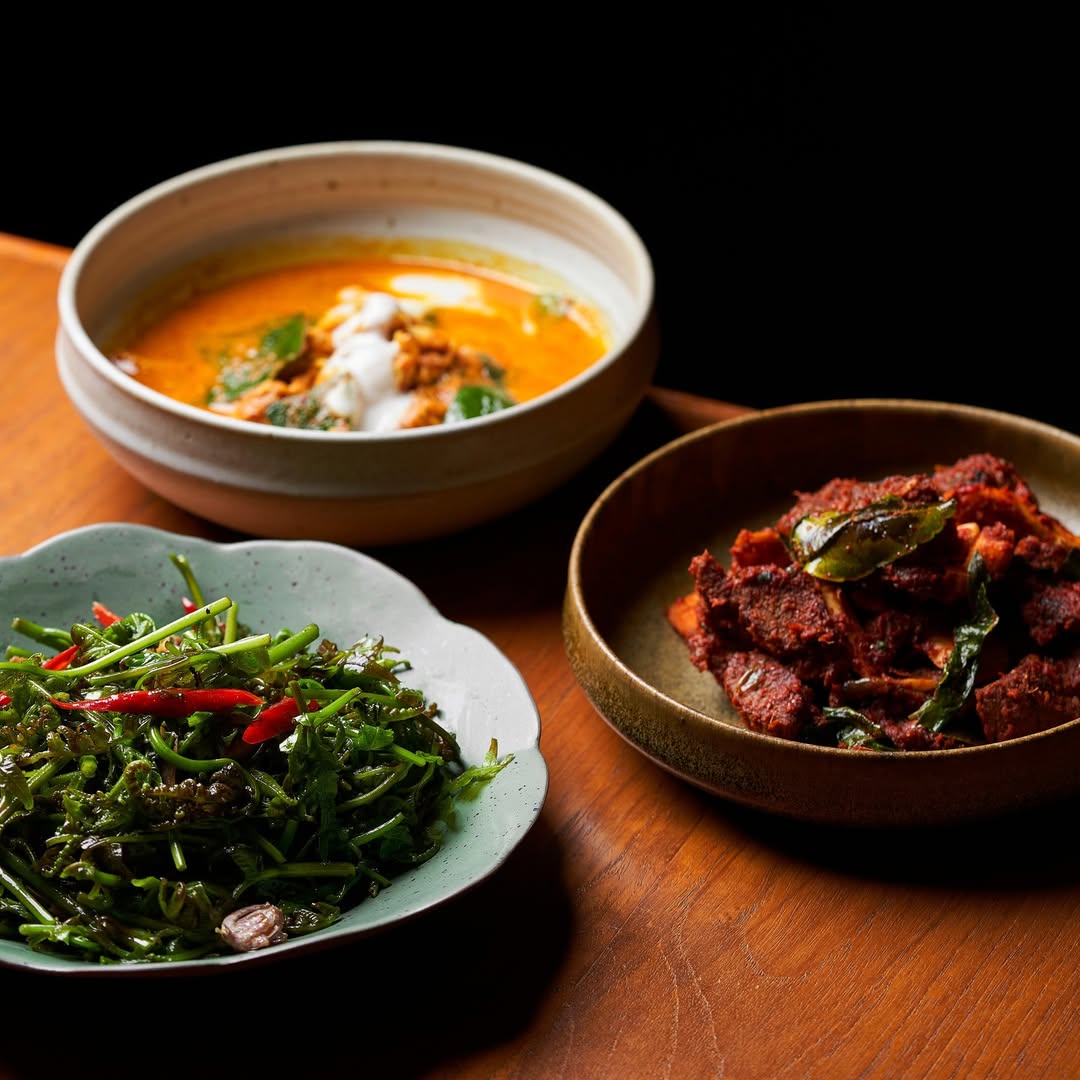
Passing Down Thai Food Wisdom
In a village outside Chiang Rai, a woman in her seventies makes sai oua the way her mother taught her sixty years ago. She doesn’t measure the spices or weigh the pork. Her hands know the ratios. Her daughter watches, helps with the grinding, but mostly absorbs the process through repetition. This is how Thai cooking knowledge transfers: through presence, observation, the slow accumulation of understanding.
Traditional Thai recipes weren’t written down. How do you document “cook until it looks right” or “add fish sauce until it tastes balanced”? The knowledge lived in the bodies of cooks, encoded in muscle memory and intuition.
Recipes Remembered, Not Written
Ask a Thai grandmother for her recipe and she’ll look confused. She just cooks. The exact amounts change based on the ingredients that day. If the limes are particularly sour, she uses less. If the chilies are mild, she adds more.
This flexibility means Thai home cooking is resilient, able to work with whatever’s available. Every cook’s version of a dish is slightly different. Your mother’s pad krapow tastes different from your aunt’s. They’re all correct.
Tools of a Thai Kitchen
Walk into a Thai kitchen and you’ll find equipment that hasn’t changed much in centuries alongside modern conveniences.
- Granite mortar and pestle (khrok hin): Massive, heavy, and irreplaceable for making curry paste. The granite’s rough surface grinds rather than chops, breaking down fibrous ingredients like lemongrass and galangal into a smooth paste that a food processor can’t match.
- Wok (krata): Thai woks are thinner than Chinese versions, heating faster and cooling quicker for better control. The high heat and curved sides allow for the rapid tossing that characterizes Thai stir-fries.
- Sticky rice basket (kratip khao): A woven bamboo container with a lid, used for storing steamed sticky rice and keeping it warm throughout the day.
- Coconut grater (kratai kut maprao): A low wooden stool with a serrated blade attached to one end. You sit on the stool and scrape halved coconuts against the blade, producing fresh grated coconut for desserts and curries.
- Clay pot (mo din): Unglazed earthenware used for slow-cooking soups and stews. The clay’s porosity allows for gentle, even heat distribution and adds a subtle earthy flavor.

Start Your Own Thai Food Journey
You don’t need to fly to Thailand to begin understanding Thai cuisine, though a culinary tour of Thailand with Yia Vang would certainly accelerate your education. You can start in your own kitchen with a few key ingredients and a willingness to taste, adjust, and taste again.
Begin with simple dishes that teach fundamental techniques. Khao pad (fried rice) teaches you about wok heat and day-old rice. Pad krapow requires only a few ingredients—holy basil, chilies, garlic, fish sauce, oyster sauce, and either pork or chicken—but it introduces you to the high-heat, quick-cooking style that defines Thai stir-fries. Tom yum soup lets you practice building a balanced broth.
Stock your pantry strategically. Fish sauce is non-negotiable; buy a good Thai brand like Red Boat or Tiparos. Palm sugar, tamarind paste, and coconut milk should follow. For fresh ingredients, locate an Asian market that stocks Thai herbs. Galangal is worth tracking down, but ginger will work in a pinch.
The mortar and pestle investment pays off if you’re serious about Thai cooking. Start with a medium-sized granite one, heavy enough to be stable but not so large it intimidates you.
Most importantly, understand that Thai cooking rewards repetition. Make the same dish five times and notice how it changes as you adjust the balance. Thailand luxury tours offer opportunities to eat with locals, visit markets, and learn from cooks who’ve been making the same dishes for decades—the kind of immersive experience that transforms how you understand Thai cuisine.
Thai cooking isn’t about following instructions. It’s about developing judgment, training your palate, and learning to balance flavors until they taste right. The recipes are just starting points. The real knowledge comes from cooking, tasting, adjusting, and cooking again until your hands know what to do. That’s when you’re not just cooking Thai food. That’s when you’re speaking Thai.



